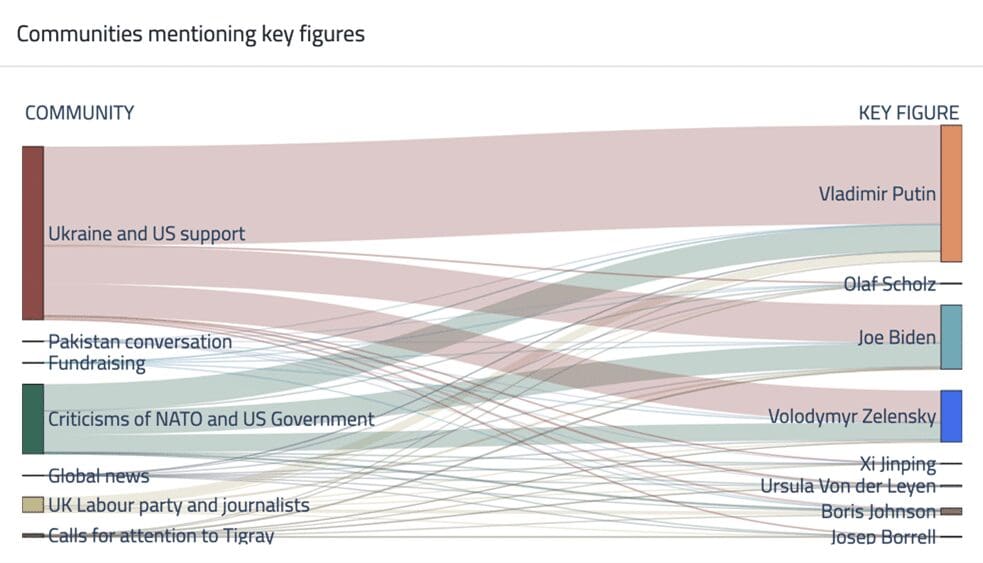To understand the narratives and key players driving the digital conversation, Constella’s team created a custom, proprietary dashboard visualizing selected dimensions of the digital public conversation pertaining to the Ukraine crisis. Our dashboard offers a tool identifying fast-moving global trends related to online conversation and the Ukraine crisis. Each week, Constella Intelligence will share notable findings from its dashboard on the Constella Intelligence blog. Below are key insights from March 21-28, 2022, from the digital public conversation related to Ukraine.
KEY INSIGHTS – MARCH 21ST TO MARCH 28TH, 2022
1. State and non-state disinformation actors populate a community critical of NATO and the US Government.
Two principal clusters dominate the core of the conversation. One of these communities includes notable public figures, including the official account of the President of the United States (@POTUS), Volodimir Zelensky (@ZelenskyyUa), and Gary Kasparov (@Kasparov63), and consists of pro-Ukraine messages and content. 40.6% of total users are identified in this community. The second largest community stands in contrast to the first. In the community titled “Criticisms of NATO and US Government” where nearly 30% of users are identified, pro-Russian and anti-western narratives are widely disseminated, and multiple actors stand out.
2. High Activity Users are heavily impacting the conversation.
This week’s data shows that 0.3% of total users were identified as high activity users, meaning that they produced a volume of results that amounted to three standard deviations greater than the average over the past week. This fraction of users produced 21.2% of total results, or more than 1 out of every 5 results captured.
3. In the Ukraine and US Support community, content and general conversations related to cyberattacks as a form of hybrid-warfare are disseminated frequently. Content related to alleged hacks, leaks, and dumps of exposed data are shared in support of pro-Ukraine motives. The digital conversation related to cyberthreats has converged with discussions related to the conflict itself and cyberattacks against Russia and any aspects of its digital infrastructure are seen to be an extension of the conflict itself. As the hybrid elements of the conflict remain relevant, we will continue to witness the evolution of data protection, cybersecurity, and cyber hostilities as domains that directly affect companies and individuals at the periphery of the geopolitical conflict.
4. Russian state propaganda is influencing online conversation, despite widespread restrictions. Russia Today (RT), a Russian state media outlet, ranked as the 7th most influential profile in this community. Notably, in March RT and Sputnik were banned from distributing their content in the EU and UK, with sweeping restrictions to these channels’ and their subsidiaries’ operations on social and broadcast media. As our analysis focuses on activity in countries like Russia, China, and Belarus, where RT is not banned, this media maintains relevance in the overall analysis through its continued activity. Official Russian state accounts, such as the official account of the Russian Ministry of Affairs. (@mfa_russia) can also be identified within this community. This account ranks 24th in terms of influence within the community, evidencing the role of engagement and diffusion of official state accounts in amplifying targeted narratives. As RT & Sputnik are banned there is evidence that embassies’ and ministers’ accounts are shifting to a more aggressive posture, demonstrating a clear pivoting of their strategy and a new tactic of influence.
COMMUNITIES – MARCH 21ST TO MARCH 28TH, 2022
1. Ukraine and US Support (40.6% of users): Pro-Ukraine conversations driven largely by prominent US politicians, Ukrainian political figures, and other public voices in support of Ukraine and against Russian military and geopolitical aggression
2. NATO and US Government Discontent (28.1% of users): Pro-Russian and anti-west narratives driven by alternative media and journalists, Russian state media, and Russian official accounts
3. UK Discontent (6.1% of users): UK Labour party members and mainstream journalists sharing Pro-Ukraine messages while criticizing Boris Johnson’s government
4. Fundraising (3.5% of users): Crypto-related accounts sharing campaigns linking the conflict to fundraisers and money-raising initiatives
5. Calls for Attention to Tigray (2.4% of users): Community trying to capture attention on Ethiopia by reframing the digital debate around Ukraine
6. Pakistan Conversation (0.3% of users): Conversation around the Organization for Islamic Cooperation’s (OIC) 48th session held this week in Pakistan
7. Global News (0.3% of users): Mainstream news and publications related to developments in the conflict

APPENDIX – MARCH 21ST TO MARCH 28TH, 2022
In the first iteration of this dashboard, we captured results related to the following 3 dimensions: Countries, Key Figures, Themes
Selected countries currently in the dashboard include: The United States, Ukraine, Russia, China, Poland, Belarus.
Selected Key Figures currently in the dashboard include: Vladimir Putin, Volodymyr Zelensky, Joe Biden, Boris Johnson, Ursula Von der Leyen, Josep Borrell, Xi Jinping, Olaf Scholz. Any mentions to these key figures are captured in the dashboard and can be visualized across multiple dimensions of analysis.
Selected themes currently in the dashboard include: Ukraine Citizens Impact, Economy, Cyberattacks, Migration Movements

Interested in seeing our Ukraine dashboard in action? Request a demo with one of our geopolitical intelligence experts.







